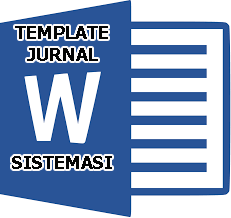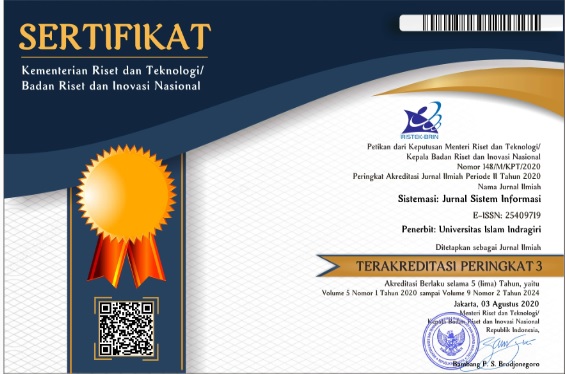Weather Classification in West Java using Ensemble Learning on Meteorological Data
Abstract
Keywords
Full Text:
PDFReferences
S. Ardhasena, Marjuki, A. F. Radjab, and H. T. Djatmiko, “At the Front Line of Climate Action,” Kedeputian Bidang Klimatologi, BMKG, 2024.
A. Rosyida, M. Aziz, Y. Firmansyah, T. Setiawan, K. P. Pangesti, and F. Kakanur I., Data Bencana Indonesia 2023, Vol. 3. Pusat Data Informasi dan Komunikasi Kebencanaan Badan Nasional Penanggulangan Bencana, 2024. [Online]. Available: https://bpbd.kepriprov.go.id/files/buku-data-bencana-indonesia-tahun-2023.pdf
E. Dritsas, M. Trigka, and P. Mylonas, “A Multi-class Classification Approach for Weather Forecasting with Machine Learning Techniques,” in 2022 17th International Workshop on Semantic and Social Media Adaptation & Personalization (SMAP), Corfu, Greece: IEEE, Nov. 2022, pp. 1–5. doi: 10.1109/SMAP56125.2022.9942121.
S. I. Fallo, M. A. Aprihartha, and J. Prasetya, “Optimization of Early Warning System for Landslides based on Rainfall using Naive Bayes Classifier and Multiclass Support Vector Machine Algorithm in Takari Region,” 2024.
A. Toha, P. Purwono, and W. Gata, “Model Prediksi Kualitas Udara dengan Support Vector Machines dengan Optimasi Hyperparameter GridSearch CV,” Buletin Ilmiah Sarjana Teknik Elektro, Vol. 4, No. 1, pp. 12–21, May 2022, doi: 10.12928/biste.v4i1.6079.
I. Srivani, M. Sridhar, K. C. T. Swamy, and D. Venkata Ratnam, “Multi-Class Classification of Ionospheric Scintillations using SMOTE-Super Learner Ensemble Technique,” Advances in Space Research, Vol. 73, No. 7, pp. 3845–3854, Apr. 2024, doi: 10.1016/j.asr.2023.09.039.
N. Larasati, “Perbandingan Regresi Logistik dan Random Forest pada Klasifikasi Cuaca Wilayah Jawa Tengah,” AKS, Vol. 14, No. 2, pp. 172–181, Sep. 2023, doi: 10.26877/aks.v14i2.15985.
G. G. Ghiffary, N. T. Amanda, R. Ardhani, B. Sartono, and A. R. Firdawanti, “Analisis Kinerja Model Stacking berbasis Random Forest dan SVM dalam Klasifikasi Rumah Tangga berdasarkan Garis Kemiskinan Makanan di Provinsi Jawa Barat,” SCI TECH ED MATH, Vol. 5, No. 3, pp. 2244–2265, Dec. 2024, doi: 10.46306/lb.v5i3.856.
S. Joses, D. Yulvida, and S. Rochimah, “Pendekatan Metode Ensemble Learning untuk Prakiraan Cuaca menggunakan Soft Voting Classifier,” J. Appl. Comput. Sci. Technol., Vol. 5, No. 1, pp. 72–80, Jun. 2024, doi: 10.52158/jacost.v5i1.741.
B. Selvanandhini and R. Karthikeyan, “Ensemble Heartguard: Integrating SVM and Random Forest for Robust Heart Disease Prediction,” eatp, May 2024, doi: 10.53555/kuey.v30i5.5662.
P. Widiharso, S. Sendari, A. N. Handayani, and N. S. F. Putri, “Performa Metode Klasifikasi Tunggal dan Ensemble Model dalam Identifikasi Baku Mutu Air,” infotekmesin, Vol. 13, No. 2, pp. 206–211, Jul. 2022, doi: 10.35970/infotekmesin.v13i2.1529.
S. Alam, M. S. Ayub, S. Arora, and M. A. Khan, “An Investigation of the Imputation Techniques for Missing Values in Ordinal Data Enhancing Clustering and Classification Analysis Validity,” Decision Analytics Journal, Vol. 9, p. 100341, Dec. 2023, doi: 10.1016/j.dajour.2023.100341.
A. Setiawan, Y. Andalantama, M. Sidiq, and Kusrini, “Predictive Analysis of Monthly Flood Variables in the Palangkaraya Area using Multiple Regression Methods and MLR, NN, KNN, Random Forest, SVM Algorithms,” in 2023 6th International Conference on Information and Communications Technology (ICOIACT), Yogyakarta, Indonesia: IEEE, Nov. 2023, pp. 224–229. doi: 10.1109/ICOIACT59844.2023.10455906.
F. D. Rahman, M. I. Z. Mulki, and A. Taryana, “Clustering dan Klasifikasi Data Cuaca Cilacap dengan menggunakan Metode K-Mean dan Random Forest,” J. SINTA: Sist. Inf. dan Teknol.Komputasi, Vol. 1, No. 2, Apr. 2024, doi: 10.61124/sinta.v1i2.15.
H. Hou et al., “Load Forecasting Combining Phase Space Reconstruction and Stacking Ensemble Learning,” IEEE Trans. on Ind. Applicat., Vol. 59, No. 2, pp. 2296–2304, Mar. 2023, doi: 10.1109/TIA.2022.3225516.
I. D. Mienye and Y. Sun, “A Survey of Ensemble Learning: Concepts, Algorithms, Applications, and Prospects,” IEEE Access, Vol. 10, pp. 99129–99149, 2022, doi: 10.1109/ACCESS.2022.3207287.
S. Zhao et al., “Attach Importance of the Bootstrap t-test Against Student’s t-test in Clinical Epidemiology: A Demonstrative Comparison using COVID-19 as an Example,” Epidemiol. Infect., Vol. 149, p. e107, 2021, doi: 10.1017/S0950268821001047.
A. Sakho, E. Malherbe, and E. Scornet, “Do We Need Rebalancing Strategies? A Theoretical and Empirical Study Around SMOTE and Its Variants,” May 22, 2025, arXiv: arXiv:2402.03819. doi: 10.48550/arXiv.2402.03819.
DOI: https://doi.org/10.32520/stmsi.v14i5.5343
Article Metrics
Abstract view : 1218 timesPDF - 403 times
Refbacks
- There are currently no refbacks.

This work is licensed under a Creative Commons Attribution-ShareAlike 4.0 International License.









